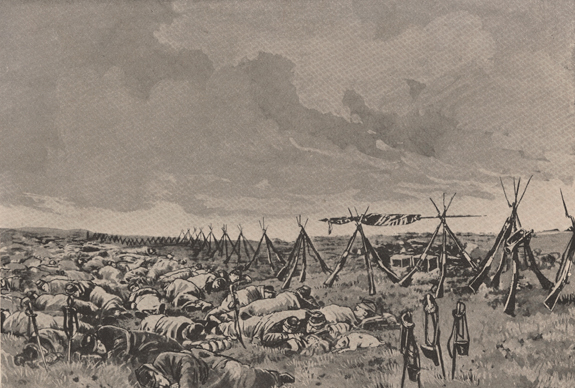Military Life
I fear some of our men are suffering from that terrible disease, home sickness. Dreams of the cheerful hearth – the comforts of home. The cheering smiles of wife, children, and friends is fast irradicting the stoical indifference of the soldier. I hope however, that the love of home and the ties of friendship are not so deep as the feelings of patriotism which should stir the whole country.
L. G. Bennett Diary, Camp Hammond, Illinois, September 17, 1861

Thousands of young men throughout the North and South enthusiastically joined the army in 1861 and 1862. Most of these volunteers joined a company that was raised near their hometown. These companies were truly a community affair. The ladies eagerly sewed uniforms and flags for the men. Close relatives often served in the ranks together including brothers, and fathers and sons.
These citizens were quickly turned into soldiers. The companies were sent to a camp of instruction where they were organized into regiments and the men introduced to army life. Hours were spent drilling. Here they learned the rudiments of maneuvering on the battlefield with linear tactics and how to fire their muskets. Some regiments were sent into the field with very little training. Midwestern states were well represented in military campaigns throughout the Ozarks. Many regiments from Illinois, Indiana, Ohio, and Wisconsin passed through this area during the war.
Military service during the Civil War was quite strenuous. Infantrymen carried at least 40 pounds of equipment, including a blanket, extra clothing, rations, and ammunition. Since the nearest railhead was at Rolla, soldiers moved throughout the area on foot. It was not uncommon for the men to march as many as 20 or 30 miles a day when campaigning. All supplies had to be brought in by wagon. The Ozarks are a rugged and mountainous region which easily broke down both men and horses. Poor roads and the terrain generally confined armies to camp in bad weather. It was here the soldiers spent most of their time. They passed the hours with many diversions including writing letters, reading, and gambling.
Civil War soldiers lived on a sparse diet. Standard army rations were salt pork or beef, hardtack, and coffee. Hardtack is of course best remembered today. Simply flour and water that was baked into a cracker like substance, it was often very hard and known to the men as “teeth-dullers” and “sheet iron crackers.” Soldiers often soaked it, or even smashed it with a musket stock to make it edible. Fruits and vegetables were noticeably absent from the soldiers diet. Civilian contractors known as sutlers were usually available to sell these items and other luxuries to the men, but often at inflated prices.
Despite the hardships, most Civil War soldiers served honorably. Soldiers in Missouri and Arkansas often faced the threat of guerrilla attacks. This danger caused them to worry greatly about their unprotected families who remained at home. Many letter and diaries in this collection express a devotion to duty, but also concern for their loved ones. Still, most were deeply committed to their cause, and thousands died for it.













